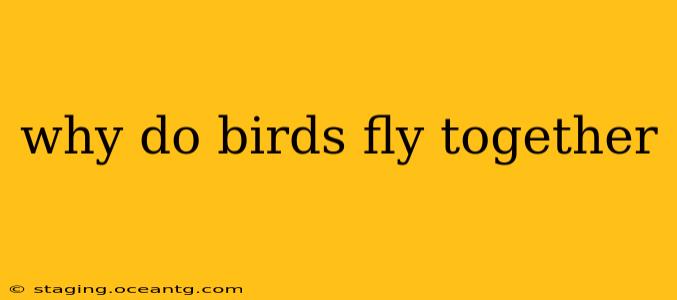Birds flying together, a breathtaking spectacle often witnessed in nature, isn't merely a pretty sight. It's a complex behavior driven by a variety of factors, offering significant advantages for survival and reproduction. Understanding why birds flock provides a fascinating glimpse into the intricate social dynamics and survival strategies of the avian world.
What are the Benefits of Birds Flying in Flocks?
The primary reason birds fly together boils down to increased safety and efficiency. Flocking offers several key advantages:
-
Predator Avoidance: This is arguably the most significant benefit. A large flock presents a confusing and overwhelming target for predators. The sheer number of birds makes it difficult for a predator to single out an individual, and the constant movement and shifting formations create a dynamic defense mechanism. The "many eyes" effect also increases vigilance, with each bird contributing to spotting potential threats.
-
Improved Foraging Efficiency: Flocking can significantly enhance foraging success. By observing the behavior of other birds, individuals can quickly locate rich food sources, saving energy and time. This is particularly important in environments with patchy or unpredictable food availability.
-
Thermoregulation: In cold weather, huddling together in large flocks helps birds conserve body heat, reducing energy expenditure needed to stay warm. This is especially crucial for smaller bird species.
-
Navigation and Migration: During migration, flying in a flock can improve navigation efficiency. Experienced birds can guide younger or less experienced individuals, ensuring successful journeys to breeding or wintering grounds. The collective knowledge and experience within a flock improve the overall navigational success rate.
Why Do Certain Bird Species Flock More Than Others?
Not all birds flock to the same degree. The tendency to flock is influenced by various factors:
-
Species-Specific Behavior: Some species are inherently more social than others. Certain birds, like starlings and swallows, are renowned for their large and incredibly complex flocks. Others, like solitary eagles, rarely flock.
-
Food Availability: Birds living in areas with abundant and predictable food resources might not need to flock as much as those competing for scarce resources. Competition for food can be a driving force behind flocking behavior.
-
Predation Pressure: Species facing high predation pressure will often show a stronger tendency to flock for increased protection. This is clearly observed in many grassland bird species.
How Do Birds Coordinate Their Flight in Flocks?
The coordination and precision in many bird flocks are astounding. Scientists have explored several theories to explain this synchronized movement:
-
Local Interactions: Birds primarily focus on their immediate neighbors, adjusting their flight path based on the positions of nearby individuals. This simple rule, repeated by each bird, creates complex, wave-like patterns.
-
Visual Cues: Birds rely heavily on visual cues to maintain their position within the flock. They constantly monitor the movements of their neighbors to adjust their own flight path.
What are some examples of birds that flock?
Many bird species demonstrate flocking behavior, but some notable examples include:
- Starlings: Famous for their incredible murmuration displays, starlings form massive, swirling flocks that can number in the hundreds of thousands.
- Swallows: These aerial acrobats often gather in large flocks, particularly during migration.
- Quail: Ground-dwelling birds that often flock for protection against predators.
- Pigeons: While often seen individually, pigeons also form flocks, particularly when foraging or roosting.
Do all flocks have a leader?
The idea of a flock leader is a common misconception. While some birds might take the initiative in certain situations (such as leading the flock during migration), there's typically no single leader controlling the movement of the entire flock. The collective behavior arises from the interactions of numerous individuals following simple rules.
In conclusion, the reasons why birds fly together are multifaceted, reflecting a sophisticated interplay between survival needs and social dynamics. From predator avoidance to enhanced foraging, the benefits of flocking are clear, highlighting the remarkable adaptations that have shaped the behavior of these fascinating creatures.
